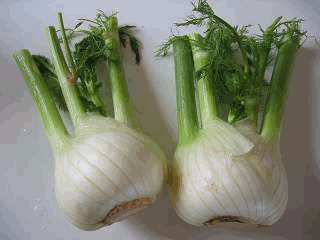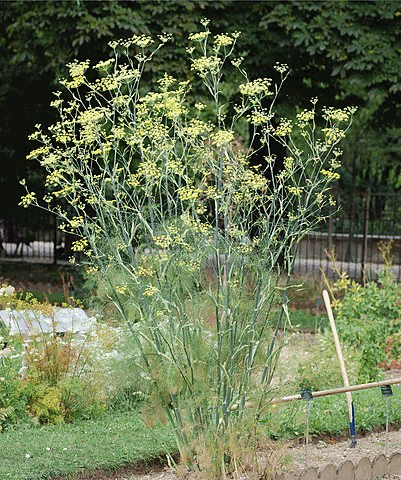Fennel
Common Names: Fennel, common fennel, ferula, flower umbel
Scientific Name: Foeniculum vulgare
Climate: Temperate
Plant Description: It is a herbaceous robust, smooth, and aromatic plant between 90 cm to 200 cm. height, that lives from one to two years. It has an erect, terete, stretched and hollow stem of a bluish green color, that is highly branched with fine textured foliage that resembles dill. The flowers are yellow in color and are found in sets that emerge from the same point, forming corsages similar to umbrellas. The fruit is small, ovoid-cylindrical, generally slightly curved, light green to yellow-brown in color. It divides into 2 mericarps at maturity. The base of its long stems intertwine to form a thick, crisp bulb that grows above the ground.
Cultivation: It grows in full sun. It prefers acid soils with good drainage.
It reproduces by seed or coppice. In seed propagation it is recommended to sow in the spring. In order to accelerate germination the seeds are soaked for one or two days before sowing. The transplant is done when the seedlings are 10-15 cm tall, sowing them at a distance of 30-45 cm. between plants. They will begin to flower approximately 90 days after planting. 
New plants can be reproduced by placing the coppice in a container of water in a sunny place and change the water every two days so that the fennel does not rot. In a few days, you should see new green shoots growing from the base. You can transplant them to the pot or directly to the ground when the shoots are 5 cm high. It needs little watering if the weather is hot and dry. To maintain it in good health it needs to be fertilized occasionally.
Fennel stalks should be cut just before flowering. The stems are generally ready for harvest 5-7 months after planting. The seed heads must be collected immediately before they break. The seed heads are ready to harvest when they turn brown. Once the stems have been harvested, the bulb can also be cleaned and stored.
If the bulb is cut about 3 cm above ground level, the stump will sprout again. Fennel produces many seeds and spreads easily and aggressively.
Uses: All parts of the plant are edible. The seeds have anise-like flavor and can be ground or crushed for use in spice mixes. The chopped stem is added to stews and pickles. The whole plant can be used to flavor the broths. The bulb and leaves are eaten as a vegetable, raw in salads, steamed, or roasted. In India, many people chew the seeds to refresh their breath.![v2l[Sin-nombre].gif](https://wikiplanta.org/uploads/images/gallery/2020-10/v2l%5BSin-nombre%5D.gif)
It has many medicinal properties - tea made with seeds treats disorders of the digestive system such as bile, colic colic of the newborn, diarrhea, poor digestion, gas, vomiting and is recommended for patients with irritable bowel syndrome. It is also used to treat coughs, and to open the pulmonary airways. Fennel helps soothe menstrual pain. The seeds are used to control blood pressure, to fight against insomnia, and altered nerves and to clean the kidney infection.
Pests and Diseases: Few pests and diseases bother fennel. If you see aphids gathering on stems, spray them with a jet of water or use natural insecticidal soap.
Its main pests are slugs and snails. To catch them, put a plastic cup with beer and leave it overnight. The slugs are going to drown in the glass.
References:
Purwaningsih H, Brink M, 1999. Foeniculum vulgare Miller. In: Proseabase [ed. by Guzman, C. C. de \Siemonsma, J.]. Bogor, Indonesia: PROSEA (Plant Resources of South-East Asia) Foundation
En Espanol: Hinojo
